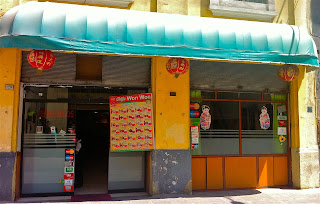 |
| Francisco Pizarro |
Lima is the capital city of Perú, located
by the coast on the desert in the Centre-West of the country, overlooking the Pacific Ocean. The population number currently is around 9 million people,
placing Lima in the fourth place on the list of largest cities in Latin America.
It’s a modern capital city, with a South American feel though.
The city was founded by
Francisco Pizarro, let’s call him Frank, on the 18th of January 1534
as “The City of the Kings” (La Ciudad de los Reyes), it became the capital of
the Viceroyalty of Perú.
Pizarro captured the Inca ruler - Atahualpa,
who was killed by Frank himself. Incas were astounded by
the look of the invaders. Spanish came on horses, not known to native Latin Americans,
dressed up in a manner neither known to Incas. As the Incas’ system was based on a
pyramid, Inca was the head of the Empire, after his death the society started
collapsing very quickly, as all the decisions were upon him. Spanish took over
the Incan Empire.
For an insight of pre-Columbian history of the region I
leave you a link to an article
“Glorious Pre-Colombian Lima”:
http://enperublog.com/2008/09/15/glorious-pre-columbian-lima/
 |
| Cathedral, resting place of Frank, also built over an ancient shrine |
After being designated as the capital of
the Viceroyalty of Perú it became one of the most important trading centres in
the America. Lima is also home to the oldest University in both Americas, which
was founded by Spanish in 1551, called
“National University of San Marcos”.
 |
| Government Palace, also former home of Frank built over an Indian ancient temple |
During the centuries it’s been prone to
pirate attacks, so in the end of XVII century the walls have been built to
protect the city.
In 1746 an earthquake devastated a third of
the city, which was quickly rebuilt under the governance of Viceroy José
Antonio Manso de Velasco.
On 28th of July 1821 Argentinean
general José de San Martín proclaimed independence of Perú from Spain, making
it one of the last countries to gain independence from Spain. Later in 1879 –
1883 Chilean troops occupied and looted the city, which took place in the
period of the War of Pacific.
Another earthquake in 1940 destroyed most
of the city, which up to that time was built from adobe and quincha. After that
Lima started growing rapidly, attracting most of the Andean population, which
came in search of better life and job opportunities. Still Lima is the major place in the country attracting people. That's all for a very short history of Lima. I recommend the modern Metropolitan Museum of Lima. The tour is guided and the museum itself very innovative, one of the best I have seen so far.
It is worth mentioning that Lima is the Gastronomical Capital of the
Americas - Spanish, Asian and Andean flavours influence the cuisine of Perú.
 |
| One of many Chifa restaurants |
The black slaves were replaced in the XIX century by Chinese workers, therefore the strong influence in their
cuisine. Current number of Chinese population in Perú is around 1,300 000 - 1,600 000 people. The Peruvian-Chinese food is called Chifa in here. There are many
restaurants serving this type of food, which de facto is delicious.
 |
| Papa a la Huancaina |
Typical Peruvian dishes are jalea (deep
fried seafood),
causa (typical starter dish made of yellow potatoes and other ingredients),
papas rellenas (stuffed potatoes),
ceviche (raw fish dish, influenced by
Japanese),
papa a la Huancaina (potatoes with spicy cheese sauce),
lomo saltado
(stir-fried beef), Tacu-tacu (rice, beans and meat),
anticuchos (skewers),
empanadas, chupe de camarones (soup)… the list goes on and on… |
| Astrid & Gastón |
 |
| Amazon fish fillet, with barley risotto, bacon sugar and carrot consomme @ Astrid & Gastón |
 |
| Magic box with alfajores, truffles, jellies and macaroons |
One of the best restaurants in the World is
here too – Astrid & Gastón. The owner is the World famous chef Gastón
Acurio, the author of the best cook book in the World. For a meal for two
people, including two piscos sour, two glasses of wine, a starter to share, two
mains and a complimentary magic box of sweets, we paid (US$ 140, including the
tip).
The most important places to see in Lima in
the next article, stay tuned!
No comments:
Post a Comment